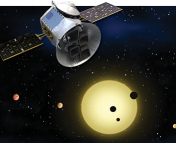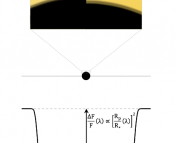Title: Analysis of a JWST NIRSpec Lab Time Series: Characterizing Systematics, Recovering Exoplanet Transit Spectroscopy, and Constraining a Noise Floor
Authors: Zafar Rustamkulov, David Sing, Rongrong Liu, and Ashley Wang
First Author’s Institution: Department of Earth and Planetary Science, Johns Hopkins University, 3400 N. Charles Street, Baltimore, MD 21218, USA
Status: Accepted to ApJ Letters [open access on arXiv]
The James Webb Space Telescope (JWST) is the most powerful infrared telescope ever built, and understandably scientists spread across the world and every subfield of astronomy can barely contain themselves waiting for the data it will soon beam back. The gorgeous shots taken during the commissioning phase for engineering/alignment suggest the measurements will be exquisite. But… how exquisite, exactly? What are the subtlest signals JWST will be able to detect, specifically in the context of exoplanet atmospheres? Today’s authors take a step towards answering that question, and impressively they do it before any scientific measurements have been taken!
How good is great?
As capable as JWST is, you could probably guess that it can’t do everything we could possibly ask of it. Although the telescope can take images of the most distant galaxies across the largest scales of the universe, all of its measurements come with some amount of uncertainty, or noise. If that noise is small compared to the signal we’re trying to measure, then we don’t need to worry— for example, if we measured the age of a rock to be 5 Myr +/- 0.01 Myr, we can be confident that it’s a young rock even if we aren’t exactly sure of its age. But, if we measured it instead to be 2 Gyr +/- 2 Gyr, suddenly our measurement looks less useful, since the rock could either be very young or nearly as old as the earth itself!
In the context of JWST and astronomy, if you measure, say, 100 photons/second from a given galaxy or star, what are the chances that source is actually shooting 100 photons/sec in our direction? Could it be 100 +/- 50 photons/sec? If you’re trying to measure a very subtle signal (say, the transit of a planet) which would only block say 40 photons/sec, the answers to those questions could make the difference between confidently detecting your planet and not being sure if it was even there!So, what are the answers? The only way to know is to analyze actual measurements taken by JWST. You would think that means we have to wait until the first science images this summer. Unless…
Blinded by the (lamp) light
Although JWST is now in its chilly home out at L2, it somewhat infamously took many years to reach this point. One reason for this was the extensive testing of every component of the telescope. As part of this testing regime, back in 2016 engineers locked the science instruments in a chamber meant to replicate the cold, vacuum-like conditions of space, then ran them through their paces to check their response. While they were in there, they forced the NIRSpec instrument to undergo the worst eye exam ever, shining a tiny lamp through its optics and onto its detector for several hours.
But ah ha! What if we just pretended that chamber actually was space, and that little lamp was actually a star? If we could clean up this data, add in a fake but perfectly known transit signal, then check how well we could recover that true signal, we’d have an estimate of NIRSpec’s noise resolution. This is exactly what today’s authors set out to do.
This wasn’t straightforward, since lamps, unfortunately, are not stars. NIRSpec breaks light into its component wavelengths to measure its spectrum, and a glowing filament produces a very different spectrum than a burning star. Even worse, lamps flicker and change over time, but contrary to what popular childrens’ songs would suggest, stars don’t actually twinkle in space. The authors took great care to remove each of the effects which could influence their recovery, sliding and smoothing each of the frames until they resembled something similar to what we’ll see from a real star in space.

After that, they artificially added in the signals of two fake planets, TRAPPIST-1e and GJ 436 b, complete with full models of their atmospheres. With realistic “measurements” of these planets now fully assembled, they could pretend that we live several months in the future and that these light curves were freshly beamed in from beyond the moon, not collected in a lab six years ago. They ran their data through similar code routines we’ll use on real data, then checked how well NIRSpec recovered their fake planets.
Noise Canceling Telescope
So, what did they find? Lots of very good news! Despite the lamp drifting around the image plane around more than we expect stars will, the authors found that NIRSpec should be able to detect spectral features from the atmospheres of both planets.

Even better, they did not run into any “noise floor”, or fundamental uncertainty the instrument can’t get around no matter how long it measures a source. Although they couldn’t give a firm estimate for it, they were able to set an upper bound and are confident that it’s smaller than 14 parts per million. That’s a tiny, tiny value, and it implies that JWST should be able to detect dozens of spectral features given enough time.
The excitement and anticipation for spectra of exoplanet atmospheres seems justified! Back to waiting those few remaining months for the first science images…
Astrobite edited by Jessie Thwaites
Featured image credit: NASA and pixabay.com




